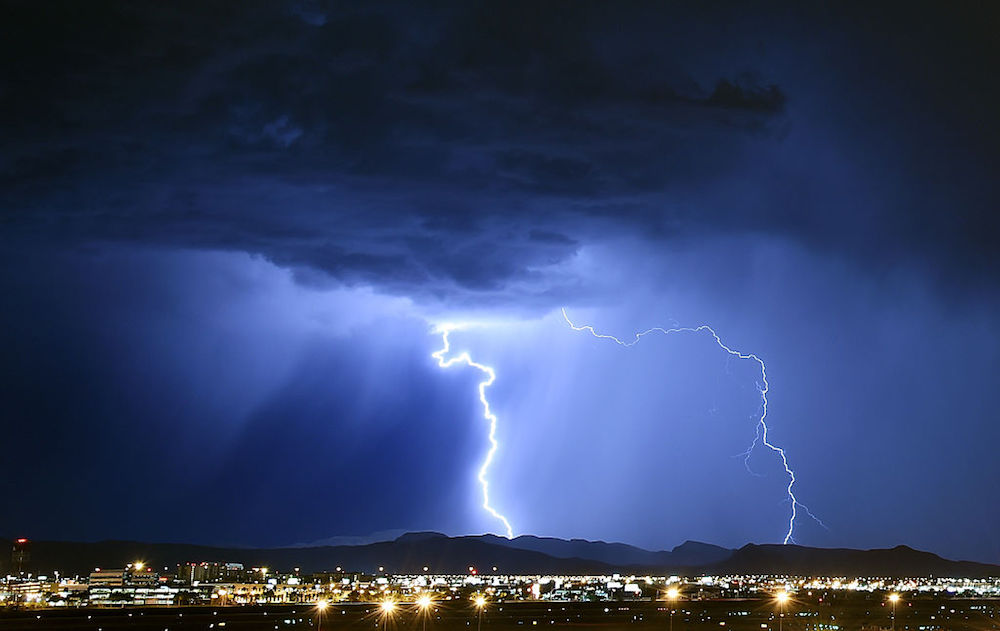
SAN FRANCISCO – Petrified lightning, or rocks that have been zapped and superheated by a lightning strike, could reveal details about the shocking weather phenomenon, new research suggests.
When lightning strikes a rock, the huge jolt of current heats up the material for microseconds, vaporizes substances inside and forms a glassy rock called fulgurite, study co-author Jiangzhi Chen, an applied physicist at the University of Pennsylvania, said here Wednesday (Dec. 14) at the annual meeting of the American Geophysical Union.
By analyzing the bubbles that form inside fulgurite, Chen and his colleagues can calculate hot the material gets, and that, in turn, can reveal insights into how exactly lightning works, Chen said. [Electric Earth: Stunning Images of Lightning]
Lightning occurs when an electrical current is transmitted from clouds to the ground, illuminating the sky and creating dangerously high voltage. But even though this is one of the more everyday occurrences in nature, scientists understand very little about how lightning actually works.
Researchers have a variety of methods of measuring the energy and current generated during a lightning strike, such as taking pictures of the actual strikes. But because lightning strikes are random, it can be hard to catch them in action. What's more, many of those methods can differ by several orders of magnitude, Chen said.
By contrast, fresh fulgurite can be easily acquired a day or two after a lightning strike. The rock is also easily distinguishable: It has reddish patches and burn marks from the lightning strike, Chen said. Fulgurite is also filled with bubbles that form when substances such as carbon dioxide, water and oxygen in the rock vaporize, Chen added.
To see if they could get understand the temperatures and energy levels reached when lightning strikes, Chen and his colleagues cut a piece of fulgurite rock from the top of Mount Mottarone in Italy. Chen then thinly sliced the rock, put it under a microscope, and characterized the size, distribution and number of vapor bubbles in the material.
Get the world’s most fascinating discoveries delivered straight to your inbox.
Scientists can determine the underlying composition of the rock by measuring the frequencies of light that reflect off of it. Knowing that, combined with a model of how frequently bubbles seed at different temperatures, Chen and his colleagues can come up with an estimation of just how hot the rock got during the lightning zap, and how long it stayed hot. That, in turn, can give some understanding of the lightning strike's total energy, he said.
Still, there are some limitations in this estimate.
When lightning strikes "only a fraction of the energy is actually transmitted to the rock," Chen told Live Science. The rest gets dissipated as it electrifies the air and causes the thunder that accompanies the strikes, among other things, he said.
Right now, the findings are a matter of pure scientific curiosity, but they could potentially make it easier to study other huge shocks to the Earth, such as bomb blasts and meteorite strikes.
"Those impact events are relatively to difficult to study, but lightning hitting a target is relatively easy to find," Chen said.
Original article on Live Science.

Tia is the editor-in-chief (premium) and was formerly managing editor and senior writer for Live Science. Her work has appeared in Scientific American, Wired.com, Science News and other outlets. She holds a master's degree in bioengineering from the University of Washington, a graduate certificate in science writing from UC Santa Cruz and a bachelor's degree in mechanical engineering from the University of Texas at Austin. Tia was part of a team at the Milwaukee Journal Sentinel that published the Empty Cradles series on preterm births, which won multiple awards, including the 2012 Casey Medal for Meritorious Journalism.


